
Marker No. G-15
Marker Text: These are the grounds of the Henry House, where occurred the main action of the First Battle of Manassas, July 21, 1861, and the closing scene of the Second Battle of Manassas, August 30, 1862.
Location: On U.S. Route 29 (Lee Highway, formerly the Warrenton Turnpike) north of VA Route 234 (Sudley Road, on the left when traveling southwest, north of the Manassas National Battlefield Park’s Stone House parking lot. Grouped with three other markers C-44 (First Battle of Manassas); C-34 (First Battle of Manassas); and G-16 (James Robinson House). Erected by the Conservation & Development Commission in 1935.
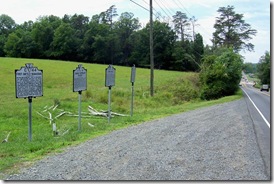 Throughout the Civil War, local citizens living near or on the battlefields of the war were placed in harms way. Many lost property, livestock, livelihoods, and their lives. Farms were burned to prevent one side or the other from receiving supplies while food supplies, cattle, pigs and other livestock were stolen to feed soldiers. Many local citizens living around or on the battlefield at First Manassas were directly affected by the battle on July 21, 1861 and in the weeks following as their homes where used as make shift hospitals for the wounded and dying.
Throughout the Civil War, local citizens living near or on the battlefields of the war were placed in harms way. Many lost property, livestock, livelihoods, and their lives. Farms were burned to prevent one side or the other from receiving supplies while food supplies, cattle, pigs and other livestock were stolen to feed soldiers. Many local citizens living around or on the battlefield at First Manassas were directly affected by the battle on July 21, 1861 and in the weeks following as their homes where used as make shift hospitals for the wounded and dying.
At the time of the battle, Henry Hill as it is called now, was called Spring Hill Farm and was owned by Mrs. Judith Carter Henry, an eighty-five year old widow confined to her bed. She lived with her daughter, Ellen Phoebe Morris. Due to her infirmity the fields surrounding the house lay fallow and in these fields the first major land battle of the Civil War would be fought.
The Henry House with the Bull Run Monument on the right behind the house.
According to legend, the elderly Judith Henry was moved from the house on a litter when the fighting on Henry Hill began on July 21, 1961. She asked to be returned to the house, however, and was struck by a stray shell. After the battle, the house was allegedly chipped into pieces and carried off by sightseers as souvenirs. The remains of the house were burned during the Second Battle of Manassas.
View from in front of the Henry House looking north toward Matthews Hill with the Stone House in the center of photo. Union troops came from Matthews Hill to this location.
Union artillery took positions on either side of the Henry House. In an attempt to dislodge Confederate sharpshooters located on the hill, Captain James B. Ricketts turned his guns on the house and fired, mortally wounding Mrs. Henry. Her daughter, Ellen had hidden herself in the fireplace and while sustaining no injuries, the loud sounds of the exploding shells cause her to lose part of her hearing. Mrs. Henry is the only known civilian death of this battle and was buried the next day in the yard beside her house.
Henry House with Mrs. Henry’s grave in front and the Visitor’s Center on right in the background.
The present house on the site was built in 1870 and in part was built on the stone foundation of the earlier Henry House, the first part having been built by a Confederate veteran named Andrew Norman. In the 1920's, the house was operated as a museum by the Sons of the Confederate Veterans. The Department of the Interior acquired the property in the late 1930's, and it is now a part of the Manassas National Battlefield Park.
 This state historical marker was originally erected about 300 yards west around the corner on Sudley Road, in front of the old road leading to the Henry House. This old road had been removed by the Park Service and Sudley road’s shoulders were made wider in the late 20th century. During these improvements the marker was moved here and was never returned to its original location. This marker stands with three other markers on the side of Lee Highway, U.S. Route 29 or the old Warrenton Turnpike.
This state historical marker was originally erected about 300 yards west around the corner on Sudley Road, in front of the old road leading to the Henry House. This old road had been removed by the Park Service and Sudley road’s shoulders were made wider in the late 20th century. During these improvements the marker was moved here and was never returned to its original location. This marker stands with three other markers on the side of Lee Highway, U.S. Route 29 or the old Warrenton Turnpike.
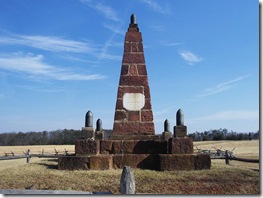 Behind the Henry House, there is a monument dedicated on June 13, 1865 by Union Soldiers to commemorate those who died at First Bull Run or First Manassas. Union troops tended to call the battle First Bull Run. After the war, many veterans of the war on both sides would regularly visit the battle sites. I know this was not the first monument of the Civil War, but it was among one of the earliest of many that would be erected by veterans of the Civil War in the years to come. For many Civil War veterans this had been their first battle. Intense memories drew both Union and Confederate soldiers back to this scene years after the war. There is a National Park Service marker next to this monument with a photo of the men who attended the dedication of the monument in 1865. The inscription on the monument reads “In memory of the Patriots who fell at Bull Run. July 21, 1861. And Erected June 13, 1865.”
Behind the Henry House, there is a monument dedicated on June 13, 1865 by Union Soldiers to commemorate those who died at First Bull Run or First Manassas. Union troops tended to call the battle First Bull Run. After the war, many veterans of the war on both sides would regularly visit the battle sites. I know this was not the first monument of the Civil War, but it was among one of the earliest of many that would be erected by veterans of the Civil War in the years to come. For many Civil War veterans this had been their first battle. Intense memories drew both Union and Confederate soldiers back to this scene years after the war. There is a National Park Service marker next to this monument with a photo of the men who attended the dedication of the monument in 1865. The inscription on the monument reads “In memory of the Patriots who fell at Bull Run. July 21, 1861. And Erected June 13, 1865.”
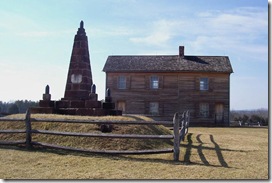 There are many accounts written by soldiers on both sides during and following the war about their observations of the horrors of the war. They describe the blood, the dead and dying soldiers on the battlefield, amputated limbs outside field hospitals and scenes of wounded soldiers being transported to hospitals. The horrors they witnessed following this and other battles destroyed any ideas about the glories of war and that this would be a short conflict.
There are many accounts written by soldiers on both sides during and following the war about their observations of the horrors of the war. They describe the blood, the dead and dying soldiers on the battlefield, amputated limbs outside field hospitals and scenes of wounded soldiers being transported to hospitals. The horrors they witnessed following this and other battles destroyed any ideas about the glories of war and that this would be a short conflict.
Private J.W. Reid of the Fourth South Carolina Infantry wrote several letters to this family between July 23 and July 30, 1861 from the vicinity of the first Manassas battlefield. The following is an excerpt from one of his letters describing the scene around him.
“The sight of the dead, the cries of the wounded, the thundering noise of the battle, can never be put to paper. It must be seen and heard to be comprehended. The dead, the dying and the wounded; friend and foe, all mixed up together; friend and foe embraced in death; some crying for water; some praying their last prayers; some trying to whisper to a friend their last farewell message to their loved one at home. It is heartrending. I cannot go any further.
Mine eyes are damp with tears. Although the fight is over the field is yet quite red with blood from the wounded and the dead. I went over what I could of the battlefield the evening after the battle ended. The sight was appalling in the extreme. There were men shot in every part of the body. Heads, legs, arms, and other parts of human bodies were lying scattered all over the battlefield.”
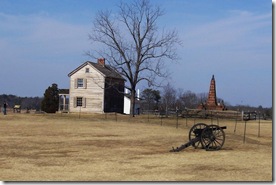
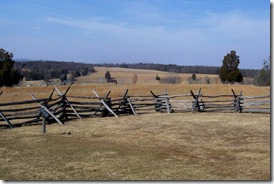
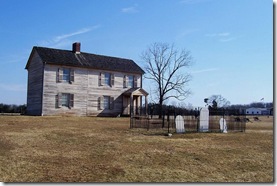
No comments:
Post a Comment